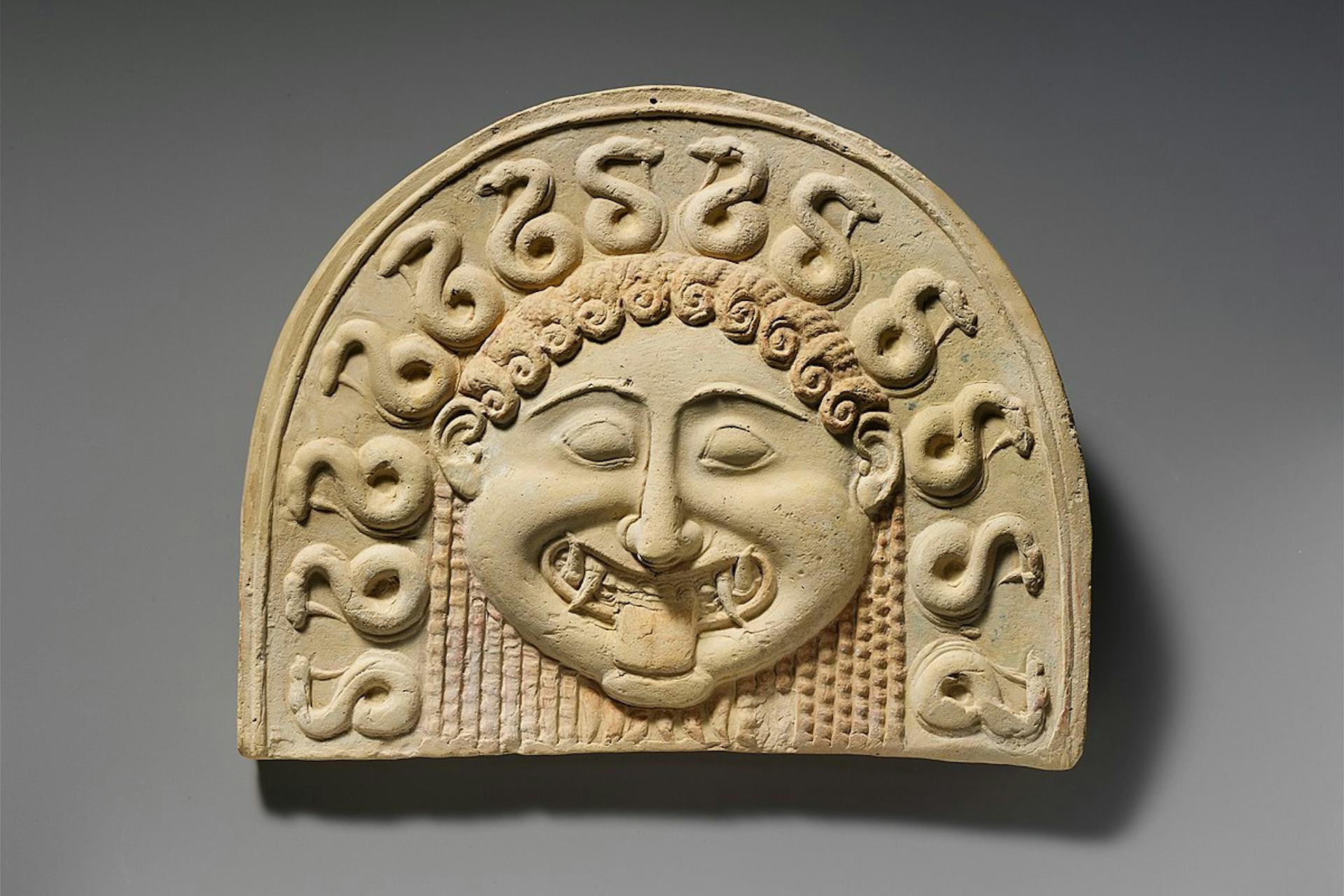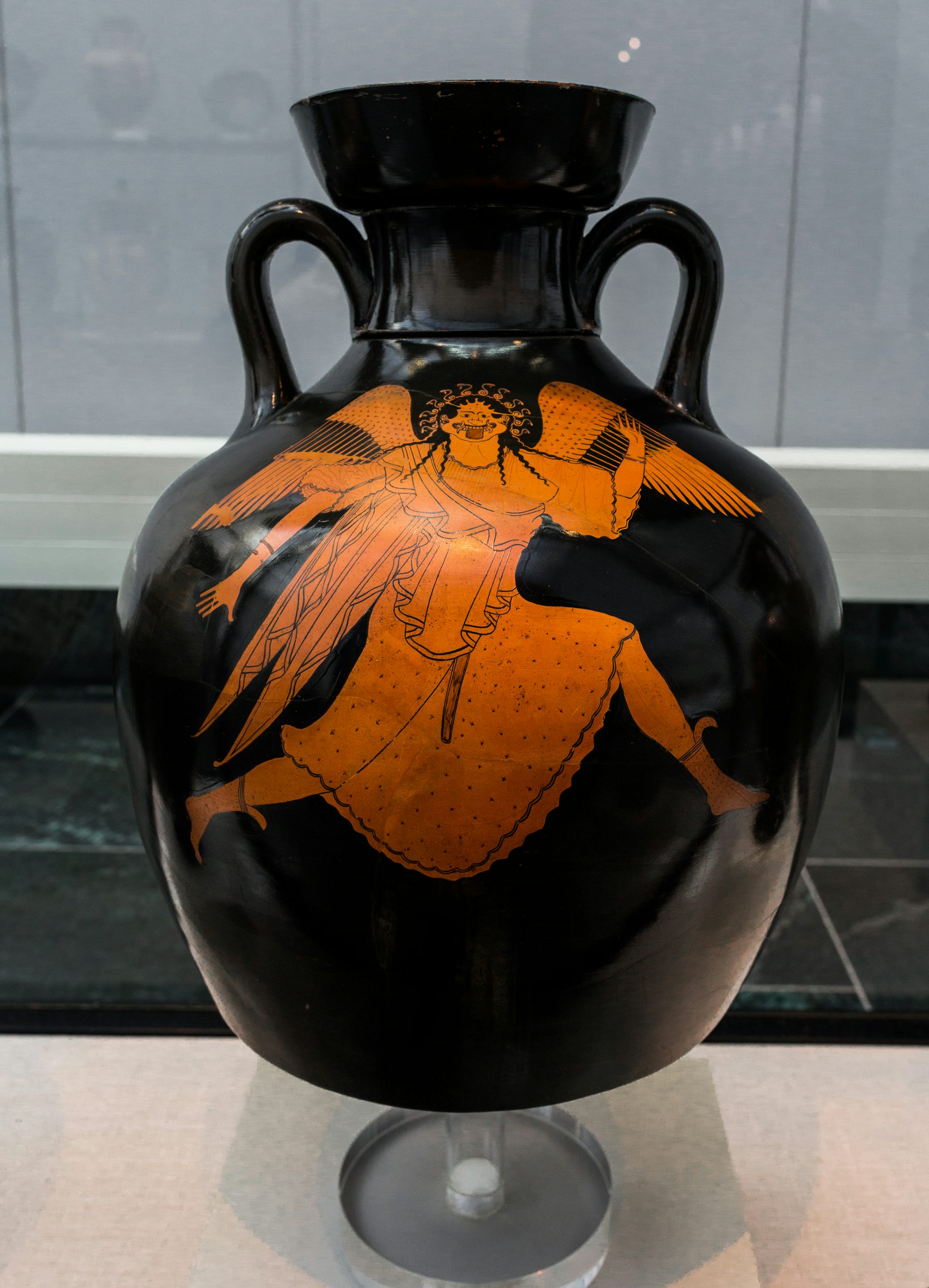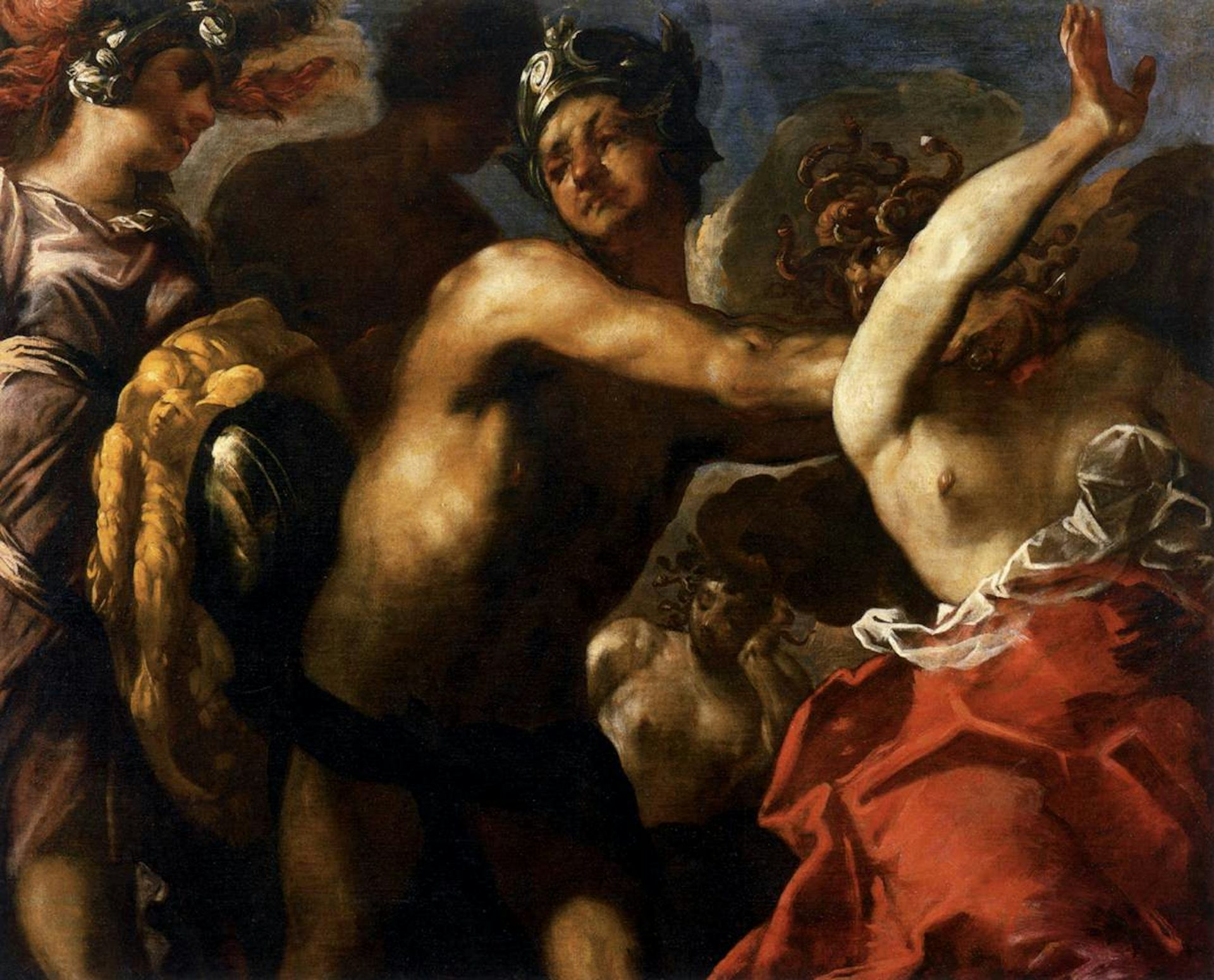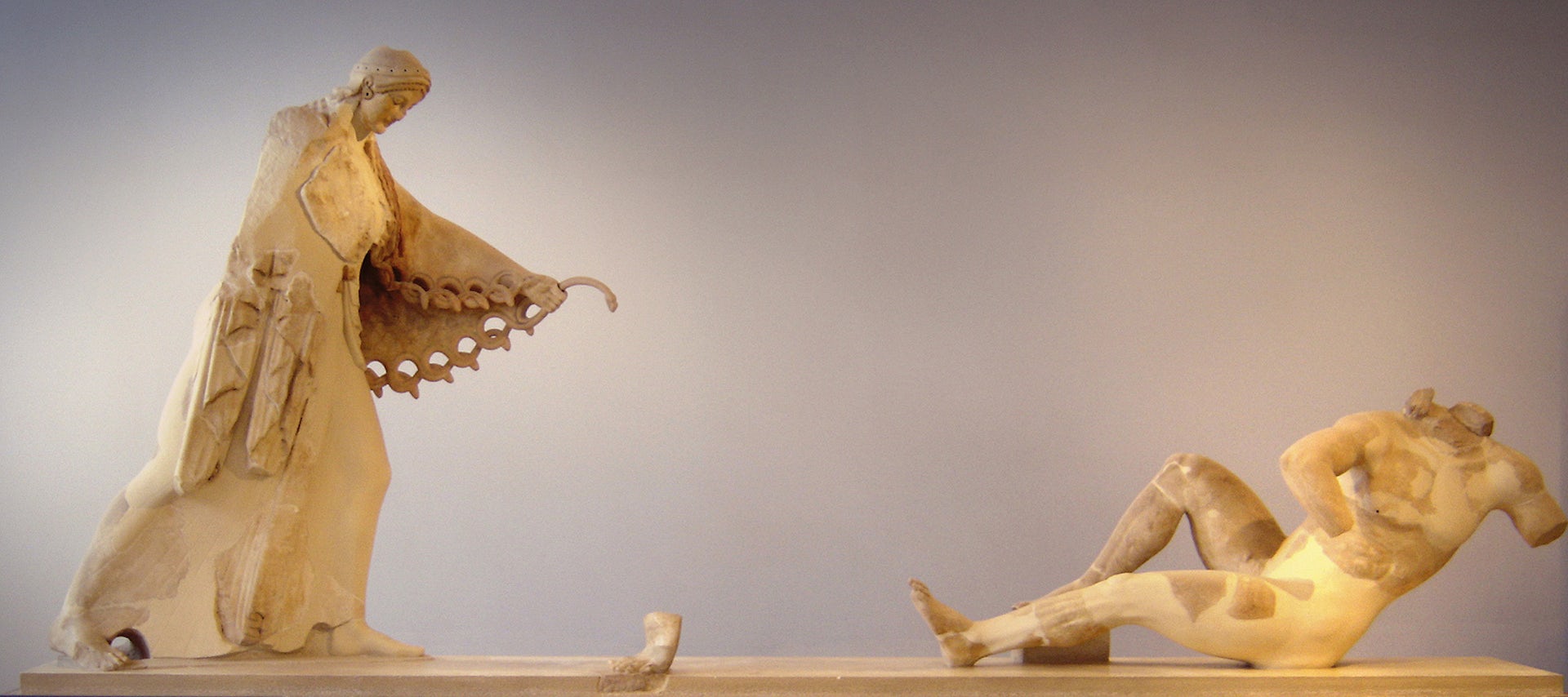Gorgons

Gorgon head on terracotta tile from Tarentum in South Italy (c. 540 BC)
The Metropolitan Museum of ArtPublic DomainOverview
The terrible, snake-haired, winged Gorgons were daughters of the sea gods Phorcys and Ceto who made their home at the very edge of the world. In the standard tradition, the Gorgons were named Sthenno, Euryale, and Medusa. Though Sthenno and Euryale were immortal, Medusa was not, and the Argive hero Perseus was sent to kill her and bring back her head. This head famously turned all who looked upon it to stone.
There were a number of different traditions surrounding the Gorgons in antiquity, in art as well as literature. For example, a Gorgon’s head—usually identified as the head of Medusa—was placed on the aegis, the great shield of the goddess Athena. The Gorgons also inspired the iconography of the Gorgoneion, a sinister representation of a Gorgon head that was believed to possess protective qualities.
Etymology
The etymology of the name “Gorgon” (Greek Γοργών/Γοργώ, translit. Gorgṓn/Gorgṓ; pl. “Gorgons,” Greek Γοργόνες, translit. Gorgónes) is somewhat obscure. It is often thought to be of Indo-European origin, likely from the same root as the Sanskrit garǧ, meaning “to make a deep sound, rumble, roar, thunder, growl.”[1]
The names of the individual Gorgons seem to emphasize their imposing, powerful, and frightening nature: Sthenno (Σθεννώ, translit. Sthennṓ; also spelled Σθενώ/Sthenṓ and Σθένουσα/Sthénousa) means “strong, forceful” (from the Greek σθένος/sthénos, “strength”); Euryale (Εὐρυάλη, translit. Euryálē) means “broad” (from the Greek εὐρύς/eurýs, “broad, wide”); and Medusa (Μέδουσα, translit. Médousa) can be translated as “protector” (from the Greek μἐδειν/médein, “to protect”).
Pronunciation
English
Greek
Gorgon, Gorgons Γοργών/Γοργώ (Gorgṓn/Gorgṓ), Γοργόνες (Gorgónes) Phonetic
IPA
[GAWR-guhn], [GAWR-guhnz] /ˈgɔr gən/, /ˈgɔr gənz/
Attributes
Locales
The Gorgons, like many monsters of Greek mythology, were associated with the most remote and extreme reaches of the world. According to Hesiod, they dwelled “beyond glorious Ocean in the frontier land towards Night where are the clear-voiced Hesperides.”[2] This seems to have meant somewhere in the Far West. Similarly, many later authors wrote that the Gorgons lived in Libya in North Africa, which for the Greeks represented the western edge of the world.[3]
Some said that the Gorgons lived on the mysterious island of Sarpedon.[4] Aeschylus, on the other hand, placed the homeland of the Gorgons near that of their sisters, the Graeae, somewhere in the Far East, near a place called Cisthene.[5] Finally, one tradition may have even located the Gorgons in the extreme north, near the land of the legendary Hyperboreans.[6]
In later literature, the Gorgons were sometimes said to live by the gates of the Underworld, alongside other horrifying monsters of mythology.[7]
Appearance and Abilities
The three Gorgons—Sthenno, Euryale, and Medusa—were famously terrifying creatures. Their defining attribute was their snake hair, though they were sometimes also represented with pointed teeth, talons, and/or wings. Though this fearsome appearance was often thought to imply ugliness,[8] some authors claimed the Gorgons were actually very beautiful.[9]
Two of the Gorgons, Sthenno and Euryale, were immortal, but their sister Medusa was mortal (it is unclear why this was the case).[10] Even so, Medusa was undeniably powerful: anyone who looked upon her face was immediately turned to stone. In some traditions, the other Gorgons may have had this power as well.[11]
In the best-known traditions, Medusa’s head (or the head of some Gorgon, not always named) was cut off and placed upon the shield of Athena, known as the aegis.[12] But the people of Argos claimed that Medusa’s head was buried underneath a mound in their marketplace, from where it protected their city.[13] For others, just a single lock of Medusa’s snake hair was enough to ward off invading enemies from a city.[14]
The blood of the Gorgons was also extremely potent. One popular tradition said that the venomous snakes of Africa were born from drops of Medusa’s blood that fell onto the sand.[15] Similarly, the Roman poet Ovid claimed that drops of Medusa’s blood that fell into the sea turned the seaweed into coral.[16] In other accounts, the blood of the Gorgons was said to possess both poisonous and healing properties.[17]
From an early period, ancient authors associated the Gorgons with the sea.[18] Their parents were the sea gods Phorcys and Ceto, and they were favored by the sea god Poseidon, who was a lover of Medusa.
Iconography
The Gorgons were a popular subject in ancient Greek art by the sixth century BCE. They were most commonly featured in depictions of the myth of Perseus, with the hero beheading the fearsome Medusa; sometimes the other Gorgons could be seen pursuing him. Images of the goddess Athena commonly showed her with a Gorgon’s head upon her shield or even her breastplate.

Attic red-figure amphora by the Berlin Painter showing a running Gorgon (ca. 490 BCE)
Staatliche Antikensammlungen, Munich / ArchaiOptixCC BY-SA 4.0The iconography of the Gorgons is above all intertwined with the Gorgoneion. The Gorgoneion was a special—and especially fearsome—representation of the Gorgon’s head, characteristically shown with a wide, round face; snake hair; a wide mouth spread in a sinister grin, exposing sharp fangs or even tusks; and a protruding tongue. This image, which was especially popular as a shield device but which can also be found in other contexts (including architecture and vase painting), was regarded as a kind of protective or “apotropaic” icon—that is, a symbol capable of warding off evil.[19]
Family
In the common tradition, the Gorgons Sthenno, Euryale, and Medusa were the daughters of the sea gods Phorcys and Ceto.[20] But according to one late author, they were the offspring of Ceto and the mysterious “Gorgo.”[21]
The Gorgons’ monstrous siblings (and half-siblings) included the Graeae—three white-haired and wizened sisters[22]—as well as, in some traditions, the dragon Ladon (guardian of the Garden of the Hesperides),[23] the snake-monster Echidna,[24] the Hesperides,[25] Scylla,[26] and Thoosa (mother of the Cyclops Polyphemus).[27]
There are occasional references in Greek literature to other Gorgons born under different circumstances and in different ways, such as emerging from the earth at the behest of the primordial earth goddess Gaia.[28]
Mythology
Origins
The myth of the Gorgons entered the Greek imagination at an early period; it was already familiar by the time the epic poet Hesiod wrote his Theogony in the eighth or seventh century BCE.[29]
The Gorgons were likely influenced by monsters of Near Eastern mythology and art. For example, their iconography bears similarities to that of the Mesopotamian demon Lamashtu (who seems to have also influenced the Greek Lamia). In addition, an important part of the myth of the Gorgon-slayer Perseus is set in the East, and the harpe—the sickle sword Perseus used to kill Medusa—shows up in similar contexts in Near Eastern art.[30]
In the Argolid, Perseus’ homeland, the myth of the Gorgons and Medusa was viewed in the context of initiation and coming-of-age rituals and beliefs: the killing of Medusa represented the first test of a young warrior, and the Gorgon’s fearsome head—with its menacing grin, bared teeth, and bulging eyes—has been thought to reflect the rage of battle, particularly the battle cry.
Medusa
Early sources tell us little about the background of the Gorgons, generally specifying no more than that they were monstrous daughters of the sea gods Phorcys and Ceto. Some later accounts, however, relate how one of the Gorgons, Medusa, was originally a beautiful girl who was loved by Poseidon. When Medusa slept with Poseidon in a shrine of Athena, the girl brought the goddess’s wrath down upon her head (more or less literally): Athena punished Medusa by turning her hair into snakes and cursing her so that anybody who looked upon her would be turned into stone.[31]
In the course of time, the hero Perseus, a mortal son of Zeus, was sent to slay Medusa. With the help of Athena, Hermes, and the nymphs, Perseus acquired the tools he would need to defeat the Gorgon: winged sandals, Hades’ helmet of invisibility, a pouch called a kibisis (for carrying Medusa’s head), and a sickle or harpe. Perseus then found the Gorgons’ lair (he forced the Graeae, the Gorgons’ gray-eyed sisters, to reveal its whereabouts to him) and decapitated Medusa as she slept, averting his own gaze so that he would not be turned to stone.[32]

Perseus Beheading Medusa by Francesco Maffei (ca. 1650)
Gallerie dell’Academia, VenicePublic DomainThe other Gorgons, hearing the dying cries of their sister, tried to catch Perseus, but with no success: Perseus had on Hades’ helmet of invisibility, so although the Gorgons chased him, they could not see him. It was said that the Gorgons’ lament for the dead Medusa became the model for flute music.[33]
As for the head of Medusa, Perseus wielded it as a potent weapon against his enemies, turning them to stone where they stood, before giving it as a gift to Athena. Athena then placed the Gorgon’s head on her shield, called the aegis, and used it to instill terror in the hearts of her enemies.[34]
Other Gorgons
There are various references to other Gorgons in early Greek literature, or to other versions of the myth of the Gorgons. In fact, it seems likely that the Gorgons originally entered Greek mythology as monsters without a fixed mythos, and that the familiar story of the three Gorgon sisters and the Gorgon-slaying Perseus was only developed later.
The Gorgon head on Athena’s shield is mentioned already in Homer’s Iliad, the most ancient work of Greek literature (dating to the eighth century BCE but containing even earlier material); but Homer does not refer to the Gorgon as “Medusa” and may not have even known the name.[35] According to Homer’s Odyssey, the Underworld goddess Persephone also possessed a Gorgon’s head, which she used against her enemies or on trespassers.[36]
In another myth, there was a Gorgon who took part in the Gigantomachy, the battle between the Olympian gods and the Giants (monstrous offspring of the earth goddess Gaia). Gaia had spawned this Gorgon, causing it to rise up from the earth to help her other children, the Giants. But Athena killed the Gorgon and used its skin as armor.[37]

Pediment from the Temple of Athena Polias in Athens showing Athena wielding the snake-fringed aegis during the Gigantomachy (ca. 525–500 BCE)
Acropolis Museum, Athens / Ricardo André FrantzCC BY-SA 3.0According to yet another tradition, it was Zeus who first used the head of the Gorgon on his armor, after learning from an oracle that he could only overcome the Titans if protected by a Gorgon’s head and goat’s skin. This armor of Zeus was the original aegis, which he subsequently gave to his daughter Athena after using it to defeat the Titans in the Titanomachy.[38]
Other Interpretations
Many ancient sources sought other explanations for the true meaning of the myth of the Gorgons. As is characteristic of such attempts at “rationalization,” these explanations are often just as unbelievable—if not more so—than the traditional myth.
According to Palaephatus, the Gorgons were actually three female rulers of African islands who owned a precious golden statue of Athena (the so-called “Gorgon”), which was stolen from them by Perseus.[39] For Dionysius Scytobrachion (cited at length by Diodorus of Sicily), the Gorgons were Libyan warrior women, very similar to the Amazons.[40] For Heraclitus, Medusa was a courtesan whose beauty stopped men in their tracks, metaphorically “turning them to stone.”[41]
Others made Medusa into a beautiful warrior queen of Libya who was killed by Perseus,[42] or into extremely hairy African beasts whose gaze turned people to stone.[43] One late author imagined Perseus as a sorcerer who used the severed head of a girl named Medusa to work his dark magic.[44]
Other writers allegorized the myth, either interpreting Perseus’ defeat of the Gorgons as virtue’s triumph over terror,[45] or imagining Perseus as the sun evaporating seawater, represented by the Gorgons.[46]
Pop Culture
The Gorgons remain important in modern pop culture. Medusa especially has appeared in numerous films, TV shows, novels, and video games; perhaps the most famous of these is her role in the 1981 film Clash of the Titans.